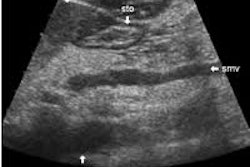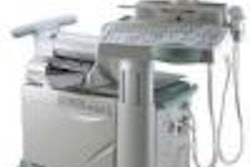(Ultrasound Review) Pediatric radiologists at the University of Innsbruck Medical School in Austria recommend the early use of ultrasound imaging of the orbit in all children with periorbital swelling and erythema.
This problem may be due to either acute superficial inflammation or orbital infection, the latter being a serious condition that may prove fatal. If orbital ultrasound demonstrates a hyperechoic or a hypoechoic lesion causing lateral displacement of the medial rectus muscle laterally, an orbital infection is highly likely, the authors wrote.
"Introducing sonography into early diagnostic interventions in pediatric patients avoids delaying appropriate treatment and allows disease monitoring on a daily basis," they said. Their findings were detailed in an article published in the December issue of American Journal of Roentgenology.
Benign inflammatory conditions of the eyelid frequently are caused by allergic reactions or local skin infections, and are limited to this region by the orbital septum. Extending between the margins of the orbit and the tarsal plate, the orbital septum forms a wall that protects the contents of the orbits from superficial inflammation.
Orbital infection is a secondary bacterial infection that most frequently spreads from an infection of the paranasal sinuses. Treatment involves hospital admission and IV administration of antibiotics, and possible surgical intervention. Clinical distinction of these two periorbital diseases is challenging, and consequently orbital infections may be misdiagnosed.
"Contrast-enhanced CT is commonly used in the diagnosis of orbital infection but exposes the patient to radiation and carries a reported risk of inaccuracy," they wrote. MR imaging or the periorbital soft tissues provides superior diagnostic accuracy compared to CT, but MR imaging in uncooperative pediatric patients is challenging, and MR imaging is not widely available.
Sonography was performed in 17 pediatric patients that had eyelid swelling and erythema, within 12 hours of admission. There were eight cases of preseptal cellulitis, seven cases of postseptal bacterial, one case of fungal postseptal infection, and one child simply had an allergic reaction.
Patients were scanned in the supine position using a 5-8 MHz curved array and 5-12 MHz linear array transducers. "The transducer was placed on the closed upper eyelid using nonirritating gel. Any pressure on the eyeball and orbital tissues was avoided," they reported.
Scans were performed in axial and coronal planes, with coronal imaging achieved by scanning from the lateral aspect of the eye with the transducer angled medially. This provided superior imaging of the medial orbital wall and medial rectus muscle.
They believe that ultrasound imaging should be the modality of choice as it enables reliable diagnosis of more serious postseptal infections. They concluded, "because of the use of nonionizing sound propagation, close monitoring of therapy progress is possible. We therefore recommend orbital sonography in every child with periorbital swelling and erythema."
Using orbital sonography to diagnose and monitor treatment of acute swelling of the eyelids in pediatric patientsMair, M et al
Department of pediatrics, section of pediatric radiology, University of Innsbruck, Innsbruck, Austria.
AJR 2002 December; 179:1529-1534
By Ultrasound Review
December 30, 2002
Copyright © 2002 AuntMinnie.com



















